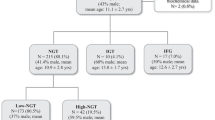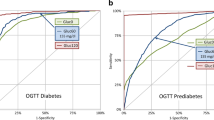Abstract
Purpose
Testing 1-h glucose (1HG) concentration during oral glucose tolerance test is cost-effective to identify individuals at risk of incident type 2 diabetes. Aim of the study was to define 1HG cutoffs diagnostic of incident impaired glucose tolerance (IGT) in youths with obesity, and to evaluate prevalence and association of cutoffs identified in the cohort and from the literature (133 and 155 mg/dl) to cardiovascular disease (CVD) in a population of youths with obesity.
Methods
This is a longitudinal study of 154 youths to identify 1HG cutoffs, and cross-sectional study of 2295 youths to estimate prevalence of high 1HG and association to CVD. Receiver-operating characteristic curves (ROC) were used to establish 1HG cutoffs, and univariate regression analyses to test association of 1HG to blood pressure, lipids and aminotransferases.
Results
ROC analysis identified the 1HG cutoff of 159 mg/dl as having diagnostic accuracy of IGT with area under the ROC 0.82 (95% CI 0.66–0.98), sensitivity 0.86% and specificity 0.79%. In the cross-sectional population, prevalence of high 1HG was 36% and 15% for 133 and 155 mg/dl cutoffs, respectively, and 17% for the 159 mg/dl value. All the examined cutoffs were significantly associated with worse lipid profile, liver function test, reduced insulin sensitivity, secretion and disposition index.
Conclusion
High 1HG is marker of persistent IGT and increased risk of metabolic abnormalities in youths. The 155 mg/dl cutoff is a convenient estimate in young people but longitudinal studies with retinopathy and overt diabetes as end points are advised to verify the 1HG cutoff with the best diagnostic accuracy.
Similar content being viewed by others
Data availability
The datasets generated during and/or analyzed during the current study are not publicly available for reasons related to privacy and participant consent but are available from the corresponding author on reasonable request.
Abbreviations
- AUC:
-
Area under the curve
- 1 and 2HG:
-
1 and 2 h glucose
- ALT:
-
Alanine aminotransferase
- AST:
-
Aspartate aminotransferase
- BMI:
-
Body mass index
- CVD:
-
Cardiovascular disease
- DBP:
-
Diastolic blood pressures
- FG:
-
Fasting glucose
- HbA1c:
-
Hemoglobin A1c
- HDL-C:
-
High-density lipoprotein cholesterol
- HOMA-IR:
-
Homeostatic assessment model algorithm of insulin resistance
- IFG:
-
Impaired fasting glucose
- IGT:
-
Impaired glucose tolerance
- IGI:
-
Insulinogenic index
- ISI:
-
Insulin sensitivity index
- NGT:
-
Normal glucose tolerance
- OPBG:
-
“Bambino Gesù” Children’s Hospital
- SBP:
-
Systolic blood pressures
- T2D:
-
Type 2 diabetes
References
International Diabetes Federation facts and figures (2021) The IDF Diabetes Atlas Tenth edition. https://www.idf.org/aboutdiabetes/what-is-diabetes/facts-figures.html. Accessed 20 Jan 2023
Andes LJ, Cheng YJ, Rolka DB, Gregg EW, Imperatore G (2020) Prevalence of prediabetes among adolescents and young adults in the United States, 2005–2016. JAMA Pediatr 174(2):e194498
Pedicelli S, Fintini D, Ravà L et al (2022) Prevalence of prediabetes in children and adolescents by class of obesity. Pediatr Obes 17(7):e12900. https://doi.org/10.1111/ijpo.12900
Unwin N, Shaw J, Zimmet P, Alberti KG (2002) Impaired glucose tolerance and impaired fasting glycaemia: the current status on definition and intervention. Diabetic Med 19(9):708–723
National Diabetes Data Group (1979) Classification and diagnosis of diabetes and other categories of glucose intolerance. Diabetes 28:1039–1057
Bergman M, Abdul-Ghani M, DeFronzo RA et al (2020) Review of methods for detecting glycemic disorders. Diabetes Res Clin Pract 165:108233. https://doi.org/10.1016/j.diabres.2020.108233. (Epub Jun 1)
Bergman M, Manco M, Sesti G et al (2018) Petition to replace current OGTT criteria for diagnosing prediabetes with the 1-hour post-load plasma glucose ≥ 155 mg/dl (8.6 mmol/L). Diabetes Res Clin Pract 146:18–33. https://doi.org/10.1016/j.diabres.2018.09.017
Andellini M, Manco M, Esposito MT, Tozzi AE, Bergman M, Ritrovato M (2022) A simulation model estimates lifetime health and economic outcomes of screening prediabetes using the 1-h plasma glucose. Acta Diabetol. https://doi.org/10.1007/s00592-022-01963-3
Paddock E, Looker HC, Piaggi P, Knowler WC, Krakoff J, Chang DC (2018) One-hour plasma glucose compared with two-hour plasma glucose in relation to diabetic retinopathy in American Indians. Diabetes Care 41(6):1212–1217. https://doi.org/10.2337/dc17-1900
Fintini D, Cappa M, Brufani C, Bernardini S, Barbetti F (2016) Prevalence of elevated 1-h plasma glucose and its associations in obese youth. Diabetes Res Clin Pract 116:202–204. https://doi.org/10.1016/j.diabres.2016.04.045
Manco M, Miraglia Del Giudice E, Spreghini MR et al (2012) 1-Hour plasma glucose in obese youth. Acta Diabetol 49(6):435–443
Tfayli H, Lee SJ, Bacha F, Arslanian S (2011) One-hour plasma glucose concentration during the OGTT: what does it tell about β-cell function relative to insulin sensitivity in overweight/obese children? Pediatr Diabetes 12(6):572–579
Tricò D, Galderisi A, Mari A, Santoro N, Caprio S (2019) One-hour post-load plasma glucose predicts progression to prediabetes in a multi-ethnic cohort of obese youths. Diabetes Obes Metab 21(5):1191–1198
RISE Consortium (2018) Metabolic contrasts between youth and adults with impaired glucose tolerance or recently diagnosed type 2 diabetes: II. Observations using the oral glucose tolerance test. Diabetes Care 41(8):1707–1716. https://doi.org/10.2337/dc18-0243
RISE Consortium (2018) Metabolic contrasts between youth and adults with impaired glucose tolerance or recently diagnosed type 2 diabetes: I Observations using the hyperglycemic clamp. Diabetes Care 41(8):1696–1706. https://doi.org/10.2337/dc18-0244
Brufani C, Tura A, Bedogni G et al (2017) Inside out the ragbag of glucose intolerance in obese adolescents. Horm Res Paediatr 87(5):287–294. https://doi.org/10.1159/000464144
Brufani C, Ciampalini P, Grossi A et al (2010) Glucose tolerance status in 510 children and adolescents attending an obesity clinic in Central Italy. Pediatr Diabetes 11(1):47–54
Shashaj B, Luciano R, Contoli B et al (2016) Reference ranges of HOMA-IR in normal-weight and obese young Caucasians. Acta Diabetol 53(2):251–260
Shashaj B, Bedogni G, Graziani MP et al (2014) Origin of cardiovascular risk in overweight preschool children: a cohort study of cardiometabolic risk factors at the onset of obesity. JAMA Pediatr 168(10):917–924
Del Chierico F, Manco M, Gardini S et al (2021) Fecal microbiota signatures of insulin resistance, inflammation, and metabolic syndrome in youth with obesity: a pilot study. Acta Diabetol 58(8):1009–1022
Manco M, Marcellini M, Devito R, Comparcola D, Sartorelli MR, Nobili V (2008) Metabolic syndrome and liver histology in paediatric non-alcoholic steatohepatitis. Int J Obes 32(2):381–387
Manco M, Bedogni G, Marcellini M et al (2008) Waist circumference correlates with liver fibrosis in children with non-alcoholic steatohepatitis. Gut 57(9):1283–1287
Balkhiyarova Z, Luciano R, Kaakinen M et al (2022) Relationship between glucose homeostasis and obesity in early life-a study of Italian children and adolescents. Hum Mol Genet 31(5):816–826
Tanner JM (1981) Growth and maturation during adolescence. Nutr Rev 39:43–55
Matthews DR, Hosker JP, Rudenski AS, Naylor BA, Treacher DF, Turner RC (1985) Homeostasis model assessment: insulin resistance and beta-cell function from fasting plasma glucose and insulin concentrations in man. Diabetologia 28(7):412–419
Matsuda M, DeFronzo RA (1999) Insulin sensitivity indices obtained from oral glucose tolerance testing: comparison with the euglycemic insulin clamp. Diabetes Care 22(9):1462–1470
Phillips DI, Clark PM, Hales CN, Osmond C (1994) Understanding oral glucose tolerance: comparison of glucose or insulin measurements during the oral glucose tolerance test with specific measurements of insulin resistance and insulin secretion. Diabet Med 11(3):286–292
Manco M, Panunzi S, Macfarlane DP, Relationship between Insulin Sensitivity and Cardiovascular Risk (RISC) Consortium et al (2010) One-hour plasma glucose identifies insulin resistance and beta-cell dysfunction in individuals with normal glucose tolerance: cross-sectional data from the relationship between Insulin sensitivity and cardiovascular risk (RISC) study. Diabetes Care 33(9):2090–2097
Pareek M, Bhatt DL, Nielsen ML et al (2018) Enhanced predictive capability of a 1-hour oral glucose tolerance test: a prospective population-based cohort study. Diabetes Care 41(1):171–177
Yudkin JS, Alberti KG, McLarty DG, Swai AB (1990) Impaired glucose tolerance. BMJ 301:397–402
Abdul-Ghani MA, Abdul-Ghani T, Ali N, Defronzo RA (2008) One-hour plasma glucose concentration and the metabolic syndrome identify subjects at high risk for future type 2 diabetes. Diabetes Care 31(8):1650–1655
Fiorentino TV, Succurro E, Andreozzi F, Sciacqua A, Perticone F, Sesti G (2019) One-hour post-load hyperglycemia combined with HbA1c identifies individuals with higher risk of cardiovascular diseases: cross-sectional data from the CATAMERI study. Diabetes Metab Res Rev 35(2):e3096
Succurro E, Arturi F, Grembiale A et al (2011) One-hour post-load plasma glucose levels are associated with elevated liver enzymes. Nutr Metab Cardiovasc Dis 21(9):713–718
Fiorentino TV, Marini MA, Andreozzi F et al (2015) One-hour postload hyperglycemia is a stronger predictor of type 2 diabetes than impaired fasting glucose. J Clin Endocrinol Metab 100(10):3744–3751
Nathan DM, Davidson MB, DeFronzo RA, Heine RJ, Henry RR, Pratley R, Zinman B, American Diabetes Association (2007) Impaired fasting glucose and impaired glucose tolerance: implications for care. Diabetes Care 30(3):753–759
Flegal KM, Ogden CL (2011) Childhood obesity: are we all speaking the same language? Adv Nutr 2(2):159S-S166
Valerio G, Maffeis C, Saggese G et al (2018) Diagnosis, treatment and prevention of pediatric obesity: consensus position statement of the Italian society for pediatric endocrinology and diabetology and the Italian society of pediatrics. Ital J Pediatr 44(1):88
Funding
The study was supported by grants to Dr Manco by European Commission under the 7th FP_Information Communication Technologies Programme_(MD-Paedigree, Model Driven Paediatric European Digital Repository, GA no 600932); by “Regione Lombardia” “Sviluppare profili genetici di rischio e trasferirli alla Sanità pubblica, in Italia”; Italian Ministry of Health grant RF-OPG-2008-1142374; FPRC 5xmille 2019 and current funds. The funding organizations had no role in the design and conduct of the study; collection, management, analysis, and interpretation of the data; preparation, review, or approval of the manuscript; and decision to submit the manuscript for publication.
Author information
Authors and Affiliations
Contributions
LR had full access to all the data in the study and take responsibility for the integrity of the data and the accuracy of the data analysis. Concept and design: MM. Acquisition, analysis, or interpretation of data: all the authors. Drafting of the manuscript: MM. Critical revision of the manuscript for important intellectual content: all the authors. Statistical analysis: LR. Obtained funding: MC, SC, MM. Supervision: MC, SC, MM.
Corresponding author
Ethics declarations
Conflict of interest
No disclosures were reported.
Ethical approval
The study was approved by the OPBG Ethics Committee (#2050/2020).
Informed consent
Written informed consent in accordance with the Helsinki declaration was obtained from the child’s parents or legal guardians. Children over age 6 and adolescents provided written absent.
Additional information
Publisher's Note
Springer Nature remains neutral with regard to jurisdictional claims in published maps and institutional affiliations.
Rights and permissions
Springer Nature or its licensor (e.g. a society or other partner) holds exclusive rights to this article under a publishing agreement with the author(s) or other rightsholder(s); author self-archiving of the accepted manuscript version of this article is solely governed by the terms of such publishing agreement and applicable law.
About this article
Cite this article
Ravà, L., Fintini, D., Mariani, M. et al. High 1-h glucose in youths with obesity as marker of prediabetes and cardiovascular risk. J Endocrinol Invest 46, 2555–2562 (2023). https://doi.org/10.1007/s40618-023-02111-6
Received:
Accepted:
Published:
Issue Date:
DOI: https://doi.org/10.1007/s40618-023-02111-6




